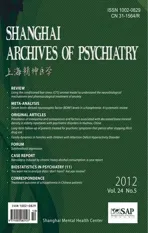Distinguishing subclinical (subthreshold) depression from the residual symptoms of major depression
2012-07-08JianlinJI
Jianlin JI*
Distinguishing subclinical (subthreshold) depression from the residual symptoms of major depression
Jianlin JI*
The terms ‘sub-clinical’ or ‘subthreshold’ are widely used in medicine to label individuals who are in the early stages of a disease process (e.g., cancer, hypertension, etc.) and to identify high-risk populations that need to be monitored or provided with specific preventative interventions or treatments. Because the pathophysiological changes that occur in the sub-clinical stages of a condition are similar to those that occur during the full-blown disease, sub-clinical states are usually considered prodromal versions of the disease under consideration.
Based on this usage, subclinical or subthreshold depression should refer to an individual who has not previously met full criteria for major depression who currently experiences depressive symptoms that are not severe enough or persistent enough to merit a diagnosis of major depression. Using this concept, a recent two-year follow-up study found that subthreshold depression can predict the subsequent occurrence of depressive disorders (OR=6.23, 95% CI=3.31-11.74) or anxiety disorders (OR=3.47, 95% CI= 1.78-6.78).[1]
Unlike other medical disciplines, in clinical psychiatry the sub-clinical and subthreshold labels are also used to describe residual clinical states after the partial remission of a full episode of a condition. For example,‘sub-clinical depression’ is often used to describe the clinical state of a patient who has not entered full remission and still has residual symptoms after treatment with antidepressants.[2,3]I believe it important to distinguish these two situations. Prodromal depressive symptoms prior to the onset of a full-criteria major depression and the residual depressive symptoms after the partial resolution of a major depressive episode may be symptomatically similar but they are clinically distinct conditions that require different interventions so it is inappropriate to combine them under a single label. Residuals symptoms following a major depressive illness require continued pharmacological and/or psychotherapeutic treatment but sub-clinical depressive symptoms prior to the first occurrence of a major depressive illness usually only require observation and follow-up. More active treatment for sub-clinical depressive symptoms is usually only justified if they persist for two years or longer (in which case the diagnosis of Dysthymic Disorder is usually applied) or if the individual has had full-criteria major depressive illness in the past and thus is at a high risk of progressing to a full-criteria episode of illness.
Collapsing these different situations under a single rubric is both inaccurate and could potentially lead to inappropriate treatment. I recommend that persistent depressive symptoms following a major depressive illness that do not meet the full criteria of the disorder be labeled ‘residual symptoms’ (not sub-clinical or subthreshold symptoms) and that the ‘sub-clinical depression’ or ‘subthreshold depression’ labels be limited to depressive symptoms that occur prior to the first onset of a full depressive episode. But depressive affect is part of the normal human condition so we must also avoid the inappropriate overuse of the sub-clinical and subthreshold labels by, for example, labeling the depressive symptoms identified in screening programs of healthy community members as ‘subthreshold depression’. Depressive symptoms in individuals without prior episodes of full-criteria depressive illness should only be given the sub-clinical or subthreshold labels if the symptoms are ‘clinically significant’, that is, when they result in significant distress or significant social or occupational dysfunction.
1. Karsten J, Hartman CA, Smit JH, Zitman FG, Beekman AT, Cuijpers P, et al. Psychiatric history and subthreshold symptoms as predictors of the occurrence of depressive or anxiety disorder within 2 years.Br J Psychiatry2011; 198(3): 206-212.
2. Work group on major depressive disorder independent review panel.Practice guideline for the treatment of patients with major depressive disorder.3rd ed. Arlington, Va: American Psychiatric Association, 2010.
3. Sartorius N, Baghai TC, Baldwin DS, Barrett B, Brand U, Fleischhacker W, et al. Antidepressant medications and other treatments of depressive disorders: a CINP Task Force report based on a review of evidence.Int J Neuropsychopharmacol2007; 10(suppl 1): S1-S207.

Professor Jianlin Ji graduated from the Shanghai No. 1 Medical School in 1983 and subsequently completed a Masters of Medical Science (specializing in Psychiatry) in 1989. He is currently the chair of the Department of Mental Health at Shanghai Fudan University School of Medicine and Director of the Department of Psychological Medicine at Zhongshan Hospital affiliated with Fudan University. He is also a board member and Fellow of the Chinese Behavioral and Psychosomatic Medicine Associations, Vice-chairman of Shanghai Mental Health Association and honorary chairman of the Expert Committee on Behavioral Medicine for the Shanghai Medical Association. His current research interests include general hospital psychiatry, and the diagnosis and treatment of depression and anxiety.
10.3969/j.issn.1002-0829.2012.05.007
Department of Psychological Medicine, Zhongshan Hospital, Fudan University, Shanghai, China
*correspondence: jianlinji@yahoo.com.cn
杂志排行
上海精神医学的其它文章
- Using the conditioned fear stress (CFS) animal model to understand the neurobiological mechanisms and pharmacological treatment of anxiety
- Serum brain-derived neurotrophic factor (BDNF) levels in schizophrenia : A systematic review
- Prevalence of osteopenia and osteoporosis and factors associated with decreased bone mineral density in elderly inpatients with psychiatric disorders in Huzhou, China
- Long-term follow-up of patients treated for psychotic symptoms that persist after stopping illicit drug use
- Family dynamics in families with children with Attention Deficit Hyperactivity Disorder
- Are subsyndromal symptomatic depression and major depressive disorder distinct disorders?
